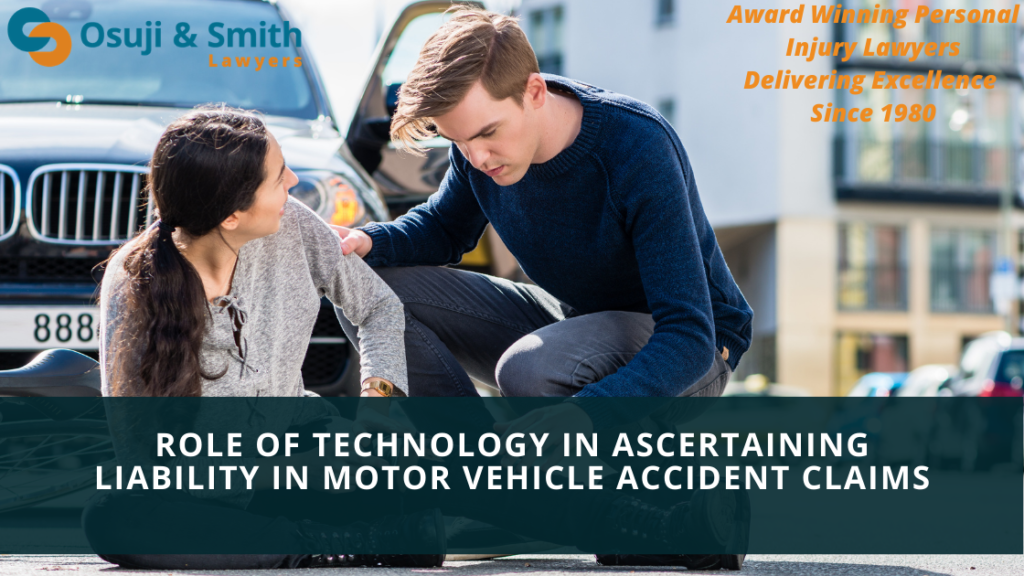Personal injury lawyers Calgary, Osuji & Smith explain: Role of technology in ascertaining liability in motor vehicle accident claims.
Scientific and technological advancement plays an important role in defining our modern society. As such, the rules that govern a civilized society keep on evolving to reflect scientific developments. The practice of law is no exception. In fact, our Constitution recognizes the “living tree doctrine” to incorporate flexibility to accommodate the realities of changing modern life.
 In the practice of injury law, the issue of “liability” in a motor vehicle accident (MVA) is central to a personal injury claim. To establish liability, it is essential to show that the defendant was negligent, reckless and failed in their duty of care causing the accident. Typically, the defendant or the insurance company for the defendant, would dispute liability and the onus will be on the plaintiff to establish same on the balance of probabilities.
In the practice of injury law, the issue of “liability” in a motor vehicle accident (MVA) is central to a personal injury claim. To establish liability, it is essential to show that the defendant was negligent, reckless and failed in their duty of care causing the accident. Typically, the defendant or the insurance company for the defendant, would dispute liability and the onus will be on the plaintiff to establish same on the balance of probabilities.
Liability in an MVA
Liability means the state of being responsible for something. The Black’s Law Dictionary defines liability as: the state of being bound or obliged in law or justice to do, pay, or make good something; legal responsibility.
In an MVA personal injury claim, the right of an injured person to claim compensation for their injuries stems from the liability of the wrongdoer causing the accident. The concept of liability is rooted in the principle that drivers of all vehicles owe a duty of care towards other users of the road and must use reasonable degree of care and caution to avoid collision. The breach of that duty of care is an offence and allows the injured person to be compensated.
Establishing liability is not an easy exercise. It involves gathering both physical and scientific evidence to show that the accident occurred due to the act or omission of the defendant. Physical evidence includes: the collision report, witness statements, pictures or video recording of the collision, pictures of the damage to the vehicle, etc. Sometimes, the physical evidence is not sufficient to establish liability and an objective detailed evidence of what exactly happened within few seconds of the collision would be required. The EDR data becomes crucial under such circumstances.
The EDR
EDR stands for Event Data Recorder in a vehicle. It is similar to a black box for airplanes. It is different from the video device log which is continuous; the EDR is specific to an event i.e. the collision. It is generally part of a vehicle’s air bag system with configuration enabled to store pre-crash vehicle dynamics and system status, recorded acceleration, driver inputs, vehicle crash signature, application of brakes, use of seatbelts or restrain system performance, air bag deployment status, post-crash data such as the activation of an automatic collision notification (ACN) system when a vehicle is involved in a collision.
The EDR system is triggered by a collision or sudden impact or changes in acceleration or application of brakes. There might be a situation when the collision is strong enough to trigger the recording, but did not deploy the airbag. Under such circumstances the data is volatile and is stored for about 3 to 4 weeks of normal driving activities. It must, therefore, be obtained in a timely manner.
While the use of EDR technology dates back to late 1990s, it was then used in only selected models. It was not until 2013, when the black box technology was standardized and implemented in North America. In 2020, approximately 99% of new vehicles in North America are equipped with EDR technology.
One can obtain the EDR from companies like Bosch, which helps in retrieving the data and provides a detailed report on the collision. Now, you can even get an app on your smart phone to retrieve the data from your vehicle in pdf form.
The role of EDR in establishing liability
The EDR data has now become an important part of MVA investigations providing objective results for collision reconstruction. EDR data is unbiased, proven, accurate and defensible. When examined together with the other physical evidence of an Accident, the EDR can provide a better understanding of what exactly happened before, during and after the crash (within few seconds prior, at and after the collision).
For establishing liability, EDR data is extremely helpful in reconstructing an accident and getting a clear picture of various elements that may have led up to the collision, including:
- What was the actual speed of the defendant’s vehicle at the time of the impact;
- Whether the defendant (driver) was wearing a seatbelt at the time of collision;
- Whether the defendant (driver) was accelerating few seconds prior to the impact;
- Whether the defendant (driver) applied brakes to reduce the speed to avoid collision;
- Whether the defendant (driver) steered the vehicle in an attempt to avoid collision;
The use of EDR data is gradually gaining recognition in personal injury law practices and proven to be an important tool in the resolution of liability in an Accident.
Please contact Osuji & Smith – Personal Injury Lawyers for all your personal injury inquiries.




